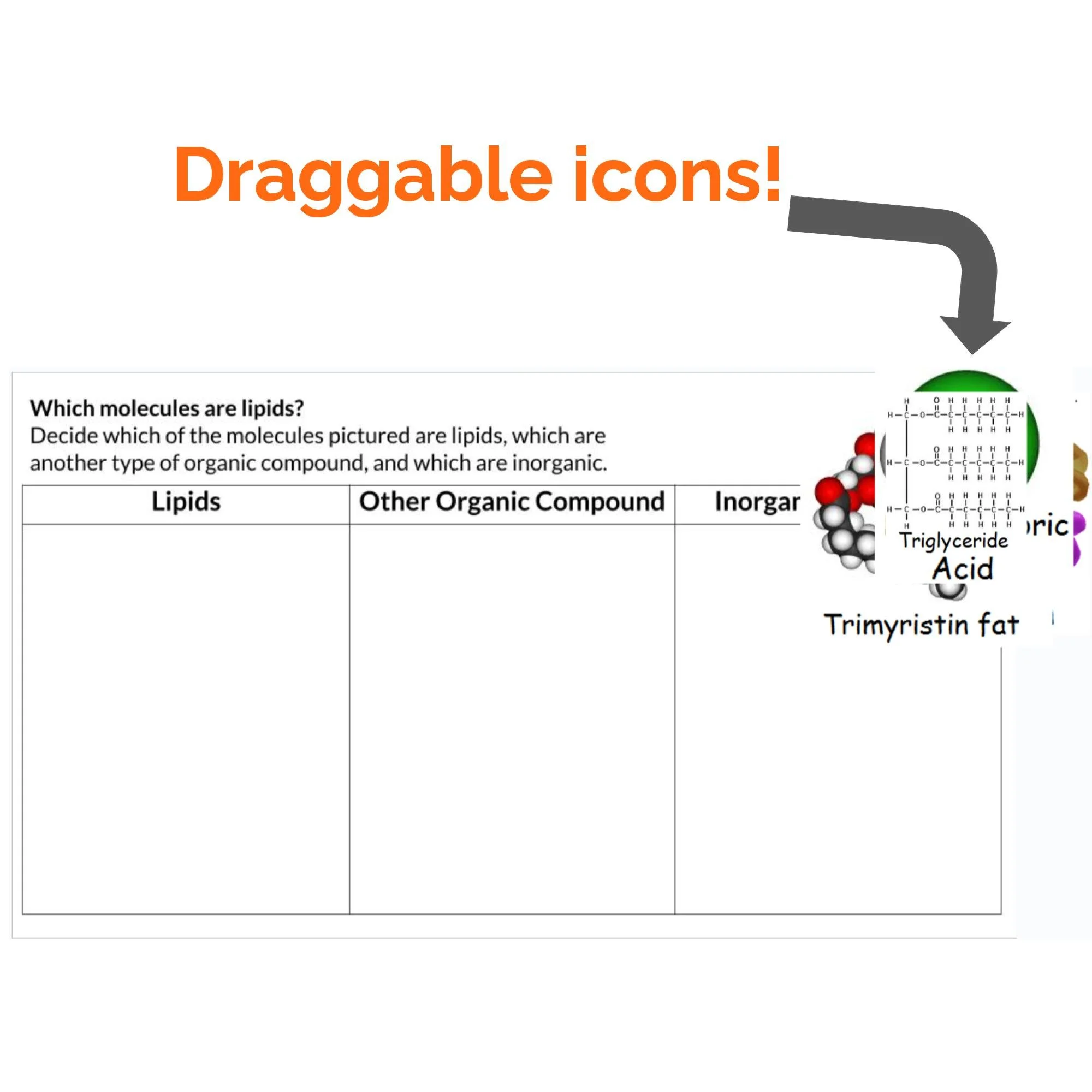



Introduction to Organic Molecules: Lipids
This remote-learning-ready Google Slides lesson is tailored to provide students with a clear understanding of the structure and function of lipids. The lesson takes a structured approach, allowing students to construct their own knowledge in an engaging digital environment.
Students commence their exploration by examining visual representations of lipids, discerning the fundamental building blocks: fatty acids and glycerol. They also identify the characteristic E-shaped structure of lipid molecules.
Next, students delve into a concise yet informative article that unveils the chemical and structural disparities between saturated fats, unsaturated fats, and trans fats. They also explore the critical processes of hydrolysis and dehydration synthesis in relation to lipids.
The lesson culminates in a hands-on activity where students categorize images of objects and molecules. They make determinations on whether they exemplify lipids, a different type of organic molecule, or an inorganic molecule. Additionally, they differentiate between saturated and unsaturated fats.
This comprehensive lesson empowers students to grasp the intricacies of lipid structure and function, ensuring a solid foundation in this vital area of biology.
Order now and equip your students with the knowledge and critical thinking skills needed to excel in the study of lipids.
Daily slide + literacy - based exit ticket included with purchase
Join the Lesson Laboratory and Teach for Tomorrow!
NGSS (Next Generation Science Standards)
High School NGSS Alignment
HS-LS1-6: Construct and revise an explanation based on evidence for how carbon, hydrogen, and oxygen from sugar molecules may combine with other elements to form amino acids and other large carbon-based molecules.
Connection: Students examine how lipids are composed primarily of carbon and hydrogen and how dehydration synthesis bonds glycerol and fatty acids together.HS-LS1-7: Use a model to illustrate that cellular respiration is a chemical process whereby the bonds of food molecules and oxygen are broken, and new compounds are formed that result in a net transfer of energy.
Connection: Students analyze how lipids function as long-term energy storage molecules in organisms.
Science & Engineering Practices:
Developing and using models
Constructing explanations
Analyzing and interpreting data
Crosscutting Concepts:
Structure and function
Systems and system models
Energy and matter
Middle School NGSS Connections (for adaptation)
MS-LS1-7: Develop a model to describe how food is rearranged through chemical reactions forming new molecules that support growth and/or release energy.
Connection: Students can model lipid synthesis and hydrolysis as chemical transformations involving energy storage.MS-PS1-2: Analyze and interpret data on the properties of substances before and after they interact to determine if a chemical reaction has occurred.
Connection: Dehydration synthesis and hydrolysis reactions provide a context for identifying chemical changes.
Common Core Standards
Grades 9–10 / 7–8:
CCSS.ELA-LITERACY.RST.9-10.2 / RST.6-8.2: Determine central ideas of a scientific text and summarize complex concepts (e.g., lipid types and their properties).
CCSS.ELA-LITERACY.RST.9-10.4 / RST.6-8.4: Determine the meaning of domain-specific words (e.g., saturated, unsaturated, hydrophobic).
CCSS.ELA-LITERACY.RST.9-10.7 / RST.6-8.7: Integrate visual information with textual descriptions (diagramming lipid structures and classifying molecule types).
CCSS.ELA-LITERACY.WHST.9-10.2 / WHST.6-8.2: Write explanatory texts that describe molecular structure and biological function.
This remote-learning-ready Google Slides lesson is tailored to provide students with a clear understanding of the structure and function of lipids. The lesson takes a structured approach, allowing students to construct their own knowledge in an engaging digital environment.
Students commence their exploration by examining visual representations of lipids, discerning the fundamental building blocks: fatty acids and glycerol. They also identify the characteristic E-shaped structure of lipid molecules.
Next, students delve into a concise yet informative article that unveils the chemical and structural disparities between saturated fats, unsaturated fats, and trans fats. They also explore the critical processes of hydrolysis and dehydration synthesis in relation to lipids.
The lesson culminates in a hands-on activity where students categorize images of objects and molecules. They make determinations on whether they exemplify lipids, a different type of organic molecule, or an inorganic molecule. Additionally, they differentiate between saturated and unsaturated fats.
This comprehensive lesson empowers students to grasp the intricacies of lipid structure and function, ensuring a solid foundation in this vital area of biology.
Order now and equip your students with the knowledge and critical thinking skills needed to excel in the study of lipids.
Daily slide + literacy - based exit ticket included with purchase
Join the Lesson Laboratory and Teach for Tomorrow!
NGSS (Next Generation Science Standards)
High School NGSS Alignment
HS-LS1-6: Construct and revise an explanation based on evidence for how carbon, hydrogen, and oxygen from sugar molecules may combine with other elements to form amino acids and other large carbon-based molecules.
Connection: Students examine how lipids are composed primarily of carbon and hydrogen and how dehydration synthesis bonds glycerol and fatty acids together.HS-LS1-7: Use a model to illustrate that cellular respiration is a chemical process whereby the bonds of food molecules and oxygen are broken, and new compounds are formed that result in a net transfer of energy.
Connection: Students analyze how lipids function as long-term energy storage molecules in organisms.
Science & Engineering Practices:
Developing and using models
Constructing explanations
Analyzing and interpreting data
Crosscutting Concepts:
Structure and function
Systems and system models
Energy and matter
Middle School NGSS Connections (for adaptation)
MS-LS1-7: Develop a model to describe how food is rearranged through chemical reactions forming new molecules that support growth and/or release energy.
Connection: Students can model lipid synthesis and hydrolysis as chemical transformations involving energy storage.MS-PS1-2: Analyze and interpret data on the properties of substances before and after they interact to determine if a chemical reaction has occurred.
Connection: Dehydration synthesis and hydrolysis reactions provide a context for identifying chemical changes.
Common Core Standards
Grades 9–10 / 7–8:
CCSS.ELA-LITERACY.RST.9-10.2 / RST.6-8.2: Determine central ideas of a scientific text and summarize complex concepts (e.g., lipid types and their properties).
CCSS.ELA-LITERACY.RST.9-10.4 / RST.6-8.4: Determine the meaning of domain-specific words (e.g., saturated, unsaturated, hydrophobic).
CCSS.ELA-LITERACY.RST.9-10.7 / RST.6-8.7: Integrate visual information with textual descriptions (diagramming lipid structures and classifying molecule types).
CCSS.ELA-LITERACY.WHST.9-10.2 / WHST.6-8.2: Write explanatory texts that describe molecular structure and biological function.